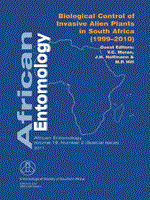Mexican poppies Argemone mexicana L. and Argemone ochroleuca Sweet subsp. ochroleuca (Papaveraceae) are annual herbs native to Central America (Mexico) that have become naturalized and weedy in many parts of the world, including South Africa. Both A. mexicana and A. ochroleuca colonize and persist in severely disturbed areas, such as cropping systems, along roadsides, railway lines and watercourses. They compete with, and possibly displace indigenous pioneer species, threatening biodiversity of riparian zones in particular. They are also toxic to animals and humans. Although control measures such as herbicides can be applied, their use in sensitive areas such as riparian zones can cause deleterious effects and therefore biological control is considered to be the most suitable and environmentally safe method to suppress these weeds. Accordingly, two species of flower- and fruit-feeding curculionid beetles provisionally identified as Conotrachelus cf. leucophaeatus Fâhraeus (Coleoptera: Curculionidae: Conotrachelini), and Sirocalodes cf. wickhami (Champion) (Curculionidae: Ceutorhynchini) were collected in Mexico in 2007 and in 2009 and brought to South Africa for evaluation as potential biological control agents. Preliminary host-specificity tests indicated that the beetles strongly prefer the target weeds to other plant species. They are highly damaging and have the potential to substantially reduce seed production and thereby curb the spread of the two Argemone species.
BioOne.org will be down briefly for maintenance on 17 December 2024 between 18:00-22:00 Pacific Time US. We apologize for any inconvenience.
How to translate text using browser tools
1 August 2011
The Initiation of a Biological Control Programme Against Argemone mexicana L. and Argemone ochroleuca Sweet subsp. ochroleuca (Papaveraceae) in South Africa
L. van der Westhuizen,
P. Mpedi
ACCESS THE FULL ARTICLE
It is not available for individual sale.
This article is only available to subscribers.
It is not available for individual sale.
It is not available for individual sale.

African Entomology
Vol. 19 • No. 2
August 2011
Vol. 19 • No. 2
August 2011
Ceutorhynchini
Conotrachelini
Conotrachelus leucophaeatus
Curculionidae
Mexican poppy
Sirocalodes wickhami




